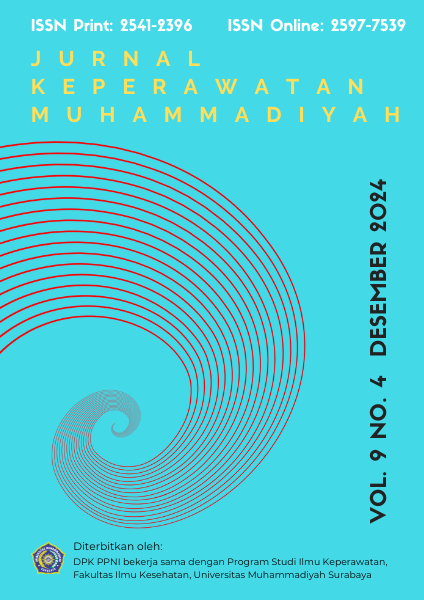Hubungan Status Fisik Pra Anestesi Dengan Waktu Pulih Sadar Pasien Post Operasi Dengan General Anesthesia
DOI:
https://doi.org/10.30651/jkm.v9i4.23184Kata Kunci:
recovery, general anasthesia, physicalAbstrak
Introduction: The duration of recovery of consciousness in postoperative patients with general anesthesia is a common problem after the patient is transferred to the recovery room. The recovery period of patients after surgery and general anesthesia is influenced by several factors, one of which is the physical condition before anesthesia based on ASA status. The purpose of this study was to determine the relationship between ASA status and the recovery time of patients after surgery with general anesthesia in the recovery room.
Method: The study design used a "cross-sectional" approach. The average population per month was 139 postoperative patients using general anesthesia aged 26-65 years. The sampling method used purposive sampling with 59 respondents. Determination of respondents was based on the inclusion criteria of patients undergoing elective surgery aged 26-65 years, patients who received ASA status 1 and 2. Data analysis tests used descriptive statistical tests to determine the characteristics of respondents.
Results: Bivariate analysis used the Spearman rank test to determine the relationship between pre-anesthesia physical status and the recovery time of patients after surgery with general anesthesia. The results of the bivariate test of ASA physical status with a p-value of 0.000.
Discussion: Pre-anesthesia physical status is related to the recovery time of patients after surgery with general anesthesia. Physical status conditions with accompanying illnesses can interfere with the anesthesia process and post-anesthesia recovery.
Referensi
Azizah, A. N., & Yomanovanka, K. A. (2022). Hubungan Status Fisik ASA Dengan Waktu Pulih Sadar Pada Pasien Pasca Anestesi Umum di RS PKU Muhammadiyah Yogyakarta. Coping: Community of Publishing in Nursing, 10(5), 524. https://doi.org/10.24843/coping.2022.v10.i05.p08.
Azmi, D. A., Wiyono, J., Dtn, I., Malang, P. K., & Malang, C. (2019). Hubungan Indeks Massa Tubuh dan Jenis Operasi Dengan Waktu Pulih Sadar Pada Pasien Post Operasi General Anestesia di Recovery Room RSUD Bangil Relationship of Body Mass Index (BMI) and Type of Operation With Time of Conscious Recover in Postoperative Pati. Jurnal Keperawatan Terapan (e-Journal), 05(02), 2442–6873.
Doyle, Daniel John, Amandeep Goyal, and Emily H. Garmon. (2022). American Society of Anesthesiologists Classification. Treasure Island: Rosadi, Setyawati, & Susanto 252 StatPearls Publishing.
Hartini, T., Siwi, A. S., & Dewi, P. (2024). Hubungan Status Fisik dengan Waktu Pulih Sadar pada Pasien dengan Inhalasi Anestesi di Ruang Pemulihan. Jurnal Penelitian Perawat Profesional, 6(3), 1063-1070.
Katzung, B.G., Masters, S.B., dan Trevor, A.J. (2014). Farmakologi Dasar dan Klinik. Edisi ke-12. Jakarta: Buku Kedokteran EGC.
Mamuasa, P. P., Ketut Mendri, N., & Ermawan, B. (2018). Hubungan Derajat Hipertensi Dengan Pemanjangan Waktu Pulih Sadar Pasien Pasca Anestesi Umum Di Rs Pku Muhammadiyah Yogyakarta. Caring : Jurnal Keperawatan, 7(2), 73–78. https://doi.org/10.29238/caring.v7i2.358.
Mecca, R. S. (2013). Postoperative Recovery. Dalam: Barash PG, Cullen BF, Stoelting RK, penyunting. Clinical Anesthesia.Edisi ke-7. Philadelphia: Lippincott Williams & Wilkins.
Misal, U. S., Joshi, S. A., Shaikh, M. M. J. A., Essays, & Researches. (2016). Delayed recovery from anesthesia: A postgraduate educational review. 10(2), 164.
Notoadmodjo, S. (2018). Metodologi Penelitian Kesehatan. Jakarta: PT Rineka Cipta.
Olfah, Y., Andisa, R., & Jitowiyono, S. (2019). The Relation of Body Mass Index and Duration of Anesthesia with Conscious Recovery Time in Children with General Anesthesia in Regional General Hospital Central Java Kebumen. Journal of Health, 6(1), 58–64. https://doi.org/10.30590/vol6-no1-p58-64.
Permatasari, E., C. Lalenoh, D., & Rahardjo, S. (2017). Pulih Sadar Pasca Anestesi yang Tertunda. Jurnal Neuroanestesi Indonesia, 6(3), 187–194. https://doi.org/10.24244/jni.vol6i3.48.
Pramono. (2017). Buku Kuliah Anestesi. jakarta: EGC.
Pratama, I. W. B. A. (2021). Hubungan Lama Operasi terhadap Waktu Pulih Sadar Pasien Post Operasi dengan General Anestesi di Rumah Sakit TK.II Udayana. Repository.Itekes-Bali, 1–78.
Pringgayuda, F., -, P., & Putra, A. E. (2020). Faktor-Faktor Yang Behubungan Dengan Hipotermi Pada Pasien Pasca General Anestesi. Jurnal Kesehatan Panca Bhakti Lampung, 8(1), 10. https://doi.org/10.47218/jkpbl.v8i1.75.
Risdayati, Rayasari, F., & Badriah, S. (2021). Analisa Faktor Waktu Pulih Sadar Pasien Post Laparatomi Anestesi Umum. Jurnal Keperawatan Silampari, 4(2), 480–486. https://doi.org/10.31539/jks.v4i2.1932.
Rizki, F. A., Hartoyo, M., & Sudiarto, S. (2019). Health Education Using the Leaflet Media Reduce Anxiety Levels in Pre Operation Patients. Jendela Nursing Journal, 3(1), 49. https://doi.org/10.31983/jnj.v3i1.4536.
Rosadi, F. F., Setiawati, M. B., & Susanto, A. (2022). Gambaran waktu pulih sadar pasca general anestesi di Rumah Sakit Jatiwinangun Purwokerto. Seminar Nasional Penelitian Dan Pengabdian Kepada Masyarakat, 245–252.
Sommeng, F. (2019). Hubungan Status Fisik Pra Anestesi Umum dengan Waktu Pulih Sadar Pasien Pasca Operasi Mastektomi di RS Ibnu Sina Februari - Maret 2017. UMI Medical Journal, 3(1), 47–58. https://doi.org/10.33096/umj.v3i1.34.
Ulfa, R. (2021). Variabel Penelitian Dalam Penelitian Pendidikan. Jurnal Pendidikan Dan Keislaman, 1(1), 342–352.
Yi, J., Lei, Y., Xu, S., Si, Y., Li, S., Xia, Z., Shi, Y., Gu, X., Yu, J., Xu, G., Gu, E., Yu, Y., Chen, Y., Jia, H., Wang, Y., Wang, X., Chai, X., Jin, X., Chen, J., … Huang, Y. (2018). Intraoperative hypothermia and its clinical outcomes in patients undergoing general anesthesia: National study in China. PLoS ONE, 12(6), 1–13. https://doi.org/10.1371/journal.pone.017722 1.
Unduhan
Diterbitkan
Terbitan
Bagian
Lisensi
Hak Cipta (c) 2024 TAUFAN ARIF, Rudi Hamarno, Maria diah Ciptaningtyas, Aditya Mauludin Afkar Nur Arij Arifaen

Artikel ini berlisensiCreative Commons Attribution-ShareAlike 4.0 International License.
- Penulis tetap memegang hak atas karyanya dan memberikan hak publikasi pertama kepada jurnal ini yang secara simultan karya tersebut dilisensikan di bawah:Â Creative Commons Attribution-ShareAlike 4.0 International (CC BY-SA 4.0)













